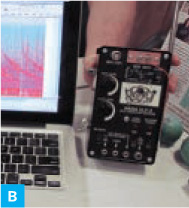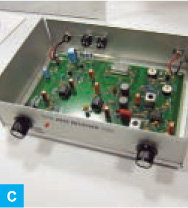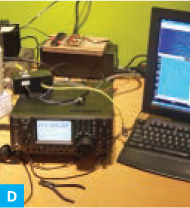Space Rock Hounds
A Q&A with the Meteorite Men.
Geoff Notkin and Steve Arnold hunt for visitors from outer space, but they aren’t looking for little green men. Their treasure is of the geologic sort: meteorites that strike Earth, carrying clues to astronomical and planetary development in the universe. The pair share their adventures in the Science Channel’s TV series Meteorite Men. We checked in with them to get their tips and insights for DIY meteorite hunters.
Q: What’s the simplest form of meteorite hunting that the DIY enthusiast can tackle?
A: Meteorites fall randomly over the entire surface of the Earth, so theoretically you could search for them anywhere. The vast majority of meteorites contain a large amount of iron, which rusts in humid environments, eventually causing the meteorite to decompose. Head out to a barren area that’s devoid of vegetation, with few indigenous rocks, and see if you can spot anything unusual.
Q: What kind of research should you do before setting out on a meteorite hunt?
A: Many types of common Earth rocks are frequently mistaken for meteorites. Become familiar with what meteorites look like, and also practice a few simple field tests that can help in identifying suspected space rocks. Our Guide to Meteorite Identification [aerolite.org/found-a-meteorite.htm] is a good place to start.

Geoff Notkin of Meteorite Men in his rover.
Photography by Suzanne Morrison ©Aerolite Meteorites;
Q: What kind of meteorite-hunting tools can you make at home, instead of having to purchase them?
A: We end up designing and building much of the equipment that we use in the field. The simplest tool, and one of the most effective, is a magnet cane. It’s basically a walking stick with a powerful magnet affixed to one end. When you’re hiking 10 or 15 miles a day, keeping your eyes peeled for unusual-looking rocks, it’s a time saver and an energy saver if you don’t have to bend down and pick up every one of them.
![]() For an extended interview with the Meteorite Men, visit: makezine.com/24/space
For an extended interview with the Meteorite Men, visit: makezine.com/24/space
Lunar Lander Simulator
INSPIRED BY ATARI’S
1979 Lunar Lander game, British engineer Iain Sharp created a lunar landing arcade machine to honor the 40th anniversary of the historic Apollo 11 mission.
Players work a steering wheel and rocket controls to safely bring the simulated Eagle lander to the moon’s surface while keeping an eye on the speed and fuel indicators.
But this isn’t a video game — Sharp’s lander dangles from fishing line manipulated by salvaged inkjet servos. Controlled by Atmel AVR microcontrollers coordinated by an Arduino, the simulator uses infrared sensors to determine the lander’s location. For a retro Space Age look, it sports vintage-looking instrumentation and nixie-tube readouts.

Iain Sharp’s 2009 Lunar Lander console game uses physical components instead of video.
Iain Sharp
Zillionaires in Space

Photograph by Adam Goss (planetarium)
It’s not absolutely necessary to be rich if you want to explore space, but it sure doesn’t hurt. Here are some financially well-endowed individuals who don’t mind spending part of their fortunes getting into orbit.
Jeff Bezos
Amazon.com’s billionaire founder has sold off $640 million of stock this year while bankrolling his Seattle-based aerospace company, Blue Origin. They’re developing escape systems for NASA rockets and planning their own suborbital space tourist flights by 2012 from their West Texas launch site.
Sir Richard Branson
The British billionaire behind the Virgin mega-brand founded Virgin Galactic in 2004, and is selling $200,000 tickets for suborbital passenger flights, by 2012 or so, from their spaceport in New Mexico.
Branson sees space travel as a way of speeding up transcontinental travel: “We’ll be going city to city by just shooting people out to space and straight back down again.”
Elon Musk
The South African founder of PayPal and Tesla Motors launched California rocket maker Space Exploration Technologies (SpaceX) in 2002.
Despite high-profile setbacks (some of Star Trek actor James “Scotty” Doohan’s ashes met their final frontier in the Pacific), the company proposes to transport payload and crew to the International Space Station (ISS), and to reach Mars with nuclear-thermal rockets.
Peter Diamandis
The X Prize founder is also a director of Virginia-based Space Adventures, the company that’s flown seven well-heeled tourists to the ISS, including video game mogul Richard Garriott and telecom millionaire Anousheh Ansari, for prices of $20 million to $35 million.
They’re now booking suborbital flights too, as well as $100 million seats for a circumnavigation of the moon.
John Carmack
The founder and top developer of Id Software (Quake, Doom, and the space-themed Commander Keen) launched Texas-based Armadillo Aerospace in 2000.
Now they’re partnering with Diamandis’ Space Adventures to develop suborbital space tourist flights for an estimated $102,000 a seat.
Sergey Brin
While Google sponsors the $30 million Lunar X Prize, its billionaire co-founder is personally headed for space. In 2008 he invested $5 million in Space Adventures, as a down payment on an estimated $35 million ride to the ISS aboard a Soyuz launched in his native Russia, as early as 2012.
DIY Inflatable Home Planetarium
Most home planetarium enthusiasts use a geodesic dome design, but Adam Goss says geodesics fall short because of their flat surfaces. The gore dome design (made from curved sections, or gores) makes a truer hemisphere, and is used in many planetariums worldwide.
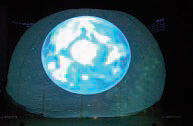
In 2009 Goss posted a tutorial for making a 5-meter inflatable gore dome. His site features free construction manuals for domes ranging from 3 to 5 meters, along with the GoreDome Calculator software that he developed for designing your own optimal planetarium dome. diyplanetarium.com
Five Cool Participatory Space Projects
Find new galaxies and design spacecraft.
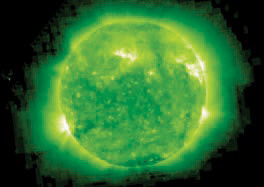
Photograph courtesy of SECCHI beacon
From launching your own satellite to analyzing aerogel, here are five ways you can make scientific discoveries and actively contribute to space exploration.
Galaxy Zoo
Classify and potentially discover new galaxies with Galaxy Zoo, a data set of thousands of galaxies imaged by the Hubble Space Telescope.
With a simple interface, a community of over 250,000 collaborators, and easy tutorials, this is a great way for kids and adults to participate in space exploration. galaxyzoo.org
Team Frednet
Google Lunar X Prize is a $30 million competition to build and send rovers, robots, and spacecraft to the moon.
Team Frednet is an open source team competing in the challenge, and anyone can join as a contributing team member leading up to the rocket launch. frednet.com
« Solar Stormwatch
Coronal mass ejections on a collision course with Earth send dangerous radiation to astronauts and can knock out communication networks and power lines.
Learn how to spot these solar explosions using near-real-time data from NASA spacecraft. solarstormwatch.com
Collaborative Space Travel and Research Team
CSTART organizes and finances the efforts of space enthusiasts around the world who use collaborative design, volunteer labor, innovative low-cost technology, and open data sharing to further the cause of manned and unmanned space exploration and research.
CSTART creates open source plans for projects ranging from sounding rockets (the OHKLA project) to manned moon landings (the CLLARE project). They also write open source software to help plan space missions and to run onboard spacecraft. cstart.org
Citizen Sky
Epsilon Aurigae is a supergiant star located 2,000 light-years from Earth that mysteriously gets eclipsed every 27.1 years by an equally large, unknown, dark object. The event has baffled scientists for 175 years, but through the Citizen Sky project, you’ll make observations and analyses that could decipher this scientific puzzle! citizensky.org
![]() Want to check out more cool participatory space projects? Explore the directory at Space-hack (spacehack.org).
Want to check out more cool participatory space projects? Explore the directory at Space-hack (spacehack.org).
Saturday Morning Science in Space
WHEN CHEMICAL ENGINEER and NASA astronaut Don Pettit spent six months aboard the International Space Station in 2002–2003, he used his off time productively. Though most of the week was busy with research and maintenance, Saturday mornings were allotted as personal time, and Pettit used the micro-g environment to conduct and document a series of fun experiments for kicks, which he called Saturday Morning Science.
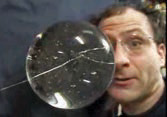
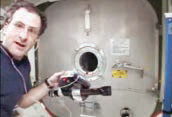
The footage is fascinating, informative, and available for free on YouTube. Using what was available on the ISS (like tea leaves, sodium chloride, and honey), Pettit demonstrates Marangoni convection, nucleate boiling, and gyroscopic platform stability, to name a few. The section on making water spheres is mesmerizing. Pettit even shows that motor-skilled repair work is possible in micro-g by repairing his broken watch. Tune in at makezine.com/go/pettit.
Cash Prizes for Space Scientists
Solve a challenge, become the first space millionaire on your block!
The Ansari X Prize for Suborbital Spaceflight (space.xprize.org/ansari-x-prize) paid $10 million to Scaled Composites LLC when its SpaceShipOne exceeded 100km in altitude. NASA realized entrepreneurs could develop technology far more efficiently, and the agency now offers tantalizing prizes to spur development of space tech.
NASA’s Space Elevator Games (spaceelevatorgames.org) provides prizes to stimulate the development of a space elevator — a line stretched from the ground to orbit, with a climbing elevator car that delivers cargo to space cheaper than a rocket. In 2009 the agency awarded $900,000 to Seattle startup LaserMotive, who created an efficient way to beam electricity to a climber.
NASA’s Regolith Excavation Challenge (regolith.csewi.org) awarded $750,000 to three teams that designed robots to dig lunar soil. The winning robot, created by college student Paul Ventimiglia, dug up 439kg of simulated regolith within 30 minutes.
Also in 2009, Peter Homer won NASA’s Astronaut Glove Challenge (astronaut-glove.us). Homer took home $250,000 in prize money, on top of $200,000 he earned in the 2007 competition. He has started his own spacesuit glove company.
Interested in getting in on the action? Here are some contests:
STUDENTS
NASA Great Moonbuggy Race
High schoolers and collegians design collapsible, human-powered moon buggies.
Purse: Bragging rights
MoonBots moonbots.org
Mixed teams of kids and adults create simulated lunar robots out of Lego Mindstorms NXT sets.
Purse: A free trip to Lego HQ in Billund, Denmark
NASA Space Settlement Contest
settlement.arc.nasa.gov/contest
Middle and high schoolers design orbital habitations in this annual contest. Teachers may download instruction packs to integrate the science of space stations into their lesson plans.
Purse: $3,000
NASA Lunabotics Mining Competition
Challenges college students to build a lunar excavator to dig up 10kg of regolith within 15 minutes.
Purse: $500–$5,000 per category
PROFESSIONALS
Google Lunar X Prize googlelunarxprize.org
Awarded to the first team to land a robot on the moon, travel 500m, and transmit back to Earth.
Purse: $30 million

Ventimiglia (3rd from left) and his Moonraker digger.
Photograph by Jamie Foster/CSA
Power Beaming Challenge
Compete to beam power to robots that climb up a cable, a critical development needed to someday assemble a space elevator.
Purse: $2 million
Strong Tether Challenge
Challenge to develop a lightweight cable strong enough to stretch from orbit to Earth.
Purse: $2 million
Sample Return Robot Challenge
Rovers must autonomously locate and collect specific geologic samples.
Purse: $1.5 million
![]() Learn about other challenges at makezine.com/24/space
Learn about other challenges at makezine.com/24/space
Space Science Gadgets You Can Make for NASA

Photography by Ryan Hickman;
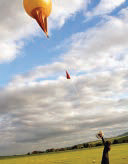
Andrew Gerrard;
NASA faces uncertainty not only about its mission, but about how to pay for it — the agency gets less than 0.6% of the federal budget. We must find ways to cut the cost of working in space.
Today the maker community is changing the economics of how to do-it-yourself in outer space, by hacking Android smartphones into tools that NASA could use for science discovery.
In December 2009, some Googlers started cellbots.com to create smartphone-controlled rovers. Two months later hackers at Noisebridge in San Francisco launched the first G1 Android phone aboard a high-altitude balloon.
In July 2010, volunteers at NASA Ames Research Center and Google launched a Nexus One aboard a suborbital fiberglass kit rocket from the site of Burning Man (see below). Two weeks later the education nonprofit Quest For Stars in San Diego launched a Motorola Droid aboard a balloon to more than 100,000 feet!
The joint cadre of volunteers at NASA Ames and Google are now hacking Android smartphone components to control robotic rovers, aerial vehicles, and small satellites, and to collect science data from them. Within a limited budget, we’re relying on students and the maker community to create and program this new class of universal, open source participatory exploration platforms.
We need immediate help to develop wi-fi, Bluetooth, or USB interfaces that can connect scientific data collection payloads to devices running the Android OS. From there, there’s boundless potential for makers to create previously unthinkable gadgets to support NASA’s mission, including:
» “Mini-Hubble” space telescopes that can send space images to amateur astronomers
» Ruggedized “cellbots” that can explore extreme environments on Earth and on near-Earth asteroids
» Remote-sensing, environmental-sampling aerial vehicles, such as balloons and helicopters, that can help analyze climate change.
What can you imagine exploring with your smart-phone? Let me know at [email protected].
Matthew F. Reyes is founder of Exploration Solutions, Inc., an education subcontractor at NASA Ames Research Center. twitter.com/motorbikematt
Androids at 28,000 Feet
As part of a series of experiments to determine the viability of using off-the-shelf smartphone components in low Earth orbit (LEO) satellites, the “AndroidSat” project successfully launched a pair of Nexus One smartphones over Nevada’s Black Rock Desert. Traveling to 28,000 feet aboard James Dougherty’s Intimidator 5 rocket, their payload successfully recorded onboard sensor data and video of the launch.
Matthew Reyes (see above), Chris Boshuizen, Will Marshall, and the NASA Ames interns associated with the launch are championing the use of smartphone components to lower the cost of deploying a satellite, and they expect it to become even more affordable with each revision.

Steve Jurvetson
Live from Outer Space!
Tune in to heavenly sounds with amateur radio.
Ham radio operators are no strangers to space communications. Astronauts use ham radio to communicate with hams on the ground, and operators use it to control satellites. If you’ve ever wanted to listen to the sounds of space — from Jupiter’s natural “radio station” to text messages sent via the moon — you don’t have to be a rocket scientist; you just need an amateur radio.
Here are a few radios you can build and/or operate to receive extraterrestrial radio signals.
Satellite Radio This Alinco DJ-G7 handheld radio (Figure A, about $300, alinco.com) and adjacent computer are receiving messages from the ARISSat-1, a homebrew satellite made by an international team of volunteers. Set to deploy from the International Space Station later this year, ARISSat-1 will broadcast a recorded message from school-children around the world, data from experiments onboard the satellite, and images from the satellite’s camera, and will allow ham radio operators to communicate with each other via the satellite’s repeater.
Photography by Diana Eng (A–C) and James Kern (D)
To receive radio signals from a satellite, you need a VHF/UHF FM radio. Attaching a yagi antenna helps (although it won’t work with this particular beacon broadcasting to school-children) — and you can make your own. (See the yagi antenna project on page 48.)
Catch a Whistler
On this computer is a visualization of a natural phenomenon called a whistler (Figure B): a radio signal created by lightning, traveling through space, skipping from one side of Earth to the other. The Inspire VLF-3 radio kit ($120, theinspireproject.org) lets you listen to frequencies emitted by lightning, ranging from 0Hz to over 100kHz: nearby lightning signals sound like a crackling fire; lightning signals that have traveled 2,000km–3,000km sound like a skipping record; and whistlers sound faintly like bottle rockets. Add a $10 antenna and you’re good to go.
Jupiter’s Jukebox
The kit-built RJ 1.1 receiver (Figure C, $155, radiojove.gsfc.nasa.gov) can be used to make a radio telescope to observe the sun and Jupiter, both of which have magnetic fields that generate radio waves. The sun’s transmissions are best heard between 18MHz and 200MHz, while Jupiter emits in the 18MHz to 40MHz frequency range.
Solar bursts usually last from 30 seconds to two minutes and sound like a light rain that becomes a downpour then lightens to a gentle pitter-patter. Jupiter’s radio waves are influenced by both planetary conditions and its orbiting moons — long bursts sound like ocean waves; short bursts sound like wind flapping a flag.
In addition to the RJ 1.1 receiver, you’ll need to build an antenna suited to receive radio signals from the sun or Jupiter (instructions are on the Radio Jove website).
Moonbounce
Here’s a home radio station that KB2FCV (aka James Kern) is working on to communicate via the moon (Figure D).
In a “moonbounce,” one operator sends a radio signal to the moon. The signal literally bounces off the moon and is received by a second operator, who can moonbounce a reply. The antenna is homemade, following the specifications at yu7ef.com.
![]() Hear radio signal audio clips from satellites, lightning, Jupiter, and beyond: makezine.com/24/space
Hear radio signal audio clips from satellites, lightning, Jupiter, and beyond: makezine.com/24/space
Diana Eng is an amateur radio operator, fashion designer from Project Runway, and author of Fashion Geek.
SuitSat
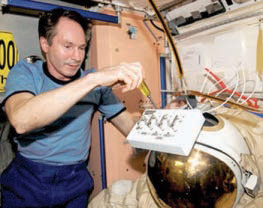
Photography by NASA/ISS program;
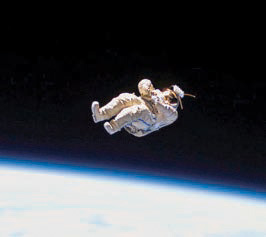
William Friend
IN FEBRUARY 2006, crew members of the International Space Station hand-launched a disem-bodied spacesuit into Earth orbit during a spacewalk.
While the sight of a human form floating away into space untethered was unsettling, the signals emanating from the spacesuit satellite were meant to captivate the imaginations of people around the globe.
SuitSat-1 was a modified Russian Orlan spacesuit previously used for extravehicular activities. Engineers and ham radio operators outfitted the suit with equipment to broadcast prerecorded messages for downlink by listeners on Earth. But after just two orbits, operators began to lose contact with SuitSat-1, and it burned up on reentry in September 2006.
A planned SuitSat-2 was renamed ARISSat-1 when a second spacesuit couldn’t be procured. Slated for launch in January 2011, ARISSat-1 will transmit radio messages and carry student experiments and solar panels that should help it run for at least six months. To learn more, check out arissat1.org.
Spaceport Sheboygan
Need to catch a flight to space? Virginia and Florida both have licensed spaceports, and the West is peppered with them. But if you live in the Midwest, then Spaceport Sheboygan may be your ticket — a proposed spaceplane hub nestled on the shore of Lake Michigan.
The Wisconsin legislature created an aerospace authority in 2006 to promote a commercial spaceport for suborbital flights, currently projected by 2015. Why here? Restricted airspace left over from an old Army base provides a window to outer space, and the lake itself is handy in the event of a water landing. And when wealthy space tourists want to make a weekend of it, Sheboygan is a lovely town with great amenities: golf, boating, fishing, an annual air show, even surfing. (You can’t say the same for Mojave, Calif., for example.)
First they’ll need to extend a runway and apply for FAA approval, but Spaceport Sheboygan (spaceportsheboygan.org) is already home to amateur rocket launches (they’ve sent Lokis to 300,000 feet), Rockets for Schools, and the Great Lakes Aerospace Science and Education Center, featuring hands-on exhibits and summer space camps. Until the spaceplanes touch down, it’s a great place to fly a shuttle simulator, check out astronaut gear that’s flown in space, and watch the rockets streaking skyward while you’re eating squeaky cheese curd.

![]() All about spaceports: hobbyspace.com/SpacePorts
All about spaceports: hobbyspace.com/SpacePorts
Backyard Astrophotography
Peter Shah brings distant galaxies down to Earth.
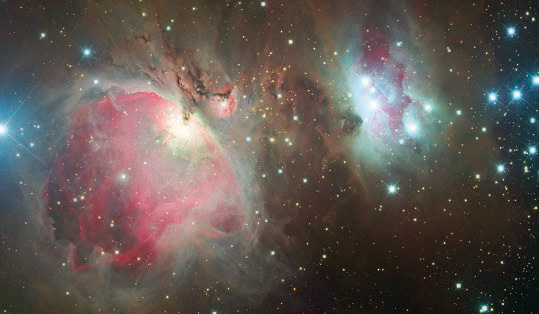
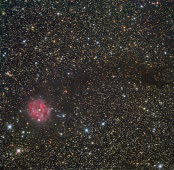

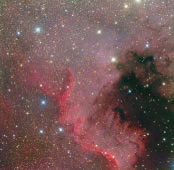
Amateur astro-photographer Shah says he learns what he needs to know as he goes along.
Photography by Peter Shah
When people see Peter Shah’s breathtaking photographs of the Andromeda Galaxy and countless nebulae, they sometimes think they’re from the Hubble Space Telescope. But Shah takes them from his backyard shed in Mid Wales in the U.K. He built it with a roll-off roof and a separate “warm” room (that isn’t really very warm at all).
“The scope is a 200mm f/3.8, AG8 Newtonian Astrograph, on a Losmandy G-11 mount,” Shah says. “I use a Sky-Watcher ED80 for guiding. The main imaging CCD is a Starlight Xpress SXVF-H16. The whole kit performs very well for a moderate imaging setup, but having nice dark skies does help too.”
Shah doesn’t pretend to be a whiz at math or astronomy, but says he learns as he goes along.
“The images that I produce are more art than science,” he says. “By the time I’ve stretched the contrast, changed the levels, and enhanced the certain areas, the whole image becomes really a lot different to what it actually is. But I do think these sorts of images are very important to astronomy, as I truly believe it’s the artists that inspire the young scientists.”
![]() More: astropix.co.uk
More: astropix.co.uk


